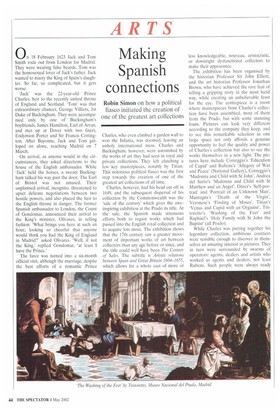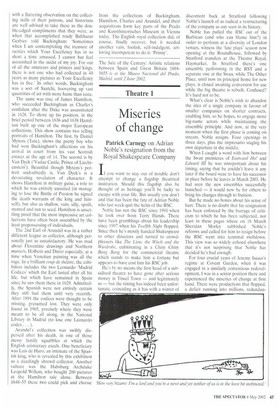Making Spanish connections
Robin Simon on how a political fiasco initiated the creation of one of the greatest art collections
On 18 February 1623 Jack and Tom Smith rode out from London for Madrid. They were wearing false beards. Tom was the homosexual lover of Jack's father. Jack wanted to marry the King of Spain's daughter. So far, so complicated, but it gets worse.
'Jack' was the 22-year-old Prince Charles, heir to the recently united throne of England and Scotland. Tom' was that extraordinary chancer, George Villiers, 1st Duke of Buckingham. They were accompanied only by one of Buckingham's boyfriends, James Hamilton, Earl of Arran, and met up at Dover with two fixers, Endymion Porter and Sir Francis Cottington. After Bayonne, Jack and Tom galloped on alone, reaching Madrid on 7 March.
On arrival, as anyone would in the circumstances, they asked directions to the house of the English ambassador. While 'Jack' held the horses, a sweaty Buckingham talked his way past the door. The Earl of Bristol was not amused. Their unplanned arrival, incognito, threatened to upset delicate negotiations between two hostile powers, and also placed the heir to the English throne in danger. The former Spanish ambassador to London, the Count of Gondomar, announced their arrival to the King's minister, Olivares, in telling fashion: 'What brings you here at such an hour, looking so cheerful that anyone would think you had the King of England in Madrid?' asked Olivares. 'Well, if not the King,' replied Gondomar, 'at least I have the Prince.'
The farce was turned into a six-month official visit, although the marriage, despite the best efforts of a romantic Prince Charles, who even climbed a garden wall to woo the Infanta, was doomed, leaving an unholy international mess. Charles and Buckingham, however, were astonished by the works of art they had seen in royal and private collections. They left clutching a few key masterpieces, notably by Titian. This notorious political fiasco was the first step towards the creation of one of the greatest art collections of all time.
Charles, however, had his head cut off in 1649, and the subsequent dispersal of his collection by the Commonwealth was the 'sale of the century' which gives the aweinspiring exhibition at the Prado its title. At the sale, the Spanish made strenuous efforts both to regain works which had passed into the English royal collection and to acquire lots more. The exhibition shows that the 17th century saw a greater movement of important works of art between collectors than any age before or since, and the title could well have been The Century of Sales. The subtitle is Artistic relations between Spain and Great Britain 1604-1655, which allows for a whole cast of more or
less knowledgeable, nouveau, aristocratic, or downright dysfunctional collectors to make their appearance.
The exhibition has been organised by the historian Professor Sir John Elliott, and the art historian Professor Jonathan Brown, who have achieved the rare feat of telling a gripping story in the most lucid way, while creating an unbelievable feast for the eye. The centrepiece is a room where masterpieces from Charles's collection have been assembled, most of them from the Prado, but with some stunning loans. Pictures can look very different according to the company they keep, and to see this remarkable selection in one large space not only affords a genuine opportunity to feel the quality and power of Charles's collection but also to see the works themselves in a new light. The pictures here include Correggio's 'Education of Cupid' and Rubens's 'Allegory of War and Peace' (National Gallery), Correggio's 'Madonna and Child with St John'. Andrea del Sarto's 'Madonna and Child with St Matthew and an Angel', Diirer's 'Self-portrait' and 'Portrait of an Unknown Man', Mantegna's 'Death of the Virgin', Veronese's 'Finding of Moses', Titian's 'Venus and Cupid with an Organist', Tintoretto's 'Washing of the Feet' and Raphael's 'Holy Family with St John the Baptist' (all Prado).
While Charles was putting together his legendary collection, ambitious courtiers were sensible enough to discover in themselves an amazing interest in pictures. They in turn were surrounded by swarms of operators: agents, dealers and artists who worked as agents and dealers, not least Rubens. Such people were always ready with a flattering observation on the collecting skills of their patrons, and historians are well advised to take these as the double-edged compliments that they were, as when that accomplished toady Balthazar Gerbier told Buckingham: 'Sometimes when I am contemplating the treasure of rarities which Your Excellency has in so short a time amassed, I cannot but feel astonished in the midst of my joy. For out of all the amateurs and princes and kings, there is not one who had collected in 40 years as many pictures as Your Excellency has in five.' In other words, Buckingham was a sort of Saatchi, hoovering up vast quantities of art with more haste than taste.
The same was true of James Hamilton, who succeeded Buckingham as Charles's confidant after the Duke was assassinated in 1628. To shore up his position, in the brief period between 1636 and 1638 Hamilton built up one of the major European collections. This show contains two telling portraits of Hamilton. The first, by Daniel Mytens (Tate), shows the pretty boy who had won Buckingham's affections on his arrival in court from his vast Scottish estates at the age of 14. The second is by Van Dyck ('Vaduz Castle, Prince of Liechtenstein'). Beautiful though Mytens's portrait undoubtedly is, Van Dyck's is a devastating revelation of character. It shows Hamilton in military guise, a role to which he was entirely unsuited (in managing to lose the Battle of Preston he signed the death warrants of the king and himself), but also as shallow, vain, silly, spoilt, stunted and run to seed. Hamilton is unsettling proof that the most impressive art collections have often been assembled by the least prepossessing of individuals.
The 2nd Earl of Arundel was in a rather different league as collector, although personally just as unsatisfactory. He was mad about Florentine drawings and Northern masters, Holbein and Diirer especially, at a time when Venetian painting was all the rage. In a brilliant coup de theatre, the exhibition includes the two Leonardo 'Madrid Codices' which the Earl lusted after all his life, but which have remained in Spain since he saw them there in 1629. Admittedly, the Spanish were not entirely certain they still had them until very recently. After 1894 the codices were thought to be missing, presumed lost. They were only found in 1965, precisely where they were meant to be all along, in the National Library in Madrid (to lose one Leonardo codex. . . ).
Arundel's collection was swiftly dispersed after his death, in one of those messy family squabbles at which the English aristocracy excels. One beneficiary was Luis de Haro, an intimate of the Spanish king, who is revealed by this exhibition as a dazzlingly shrewd collector. Another vulture was the Habsburg Archduke Leopold Willem, who bought 200 pictures at the Hamilton sale alone. Between 1648-55 these two could pick and choose from the collections of Buckingham, Hamilton, Charles and Arundel, and their acquisitions form key parts of the Prado and Kunsthistorisches Museum in Vienna today. The English royal collection did, of course, finally recover, but it needed another vain, foolish, self-indulgent, artloving incompetent to do it: Prinny'.
The Sale of the Century: Artistic relations between Spain and Great Britain 16041655 is at the Museo Nacional del Prado, Madrid, until 2 June 2002.







































































 Previous page
Previous page